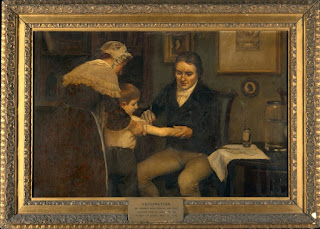If you have a scientific bent, you have probably heard of Edward Jenner, an English surgeon
Two years later, Jenner returned to Berkeley in Gloucestershire to become the local doctor and surgeon. One of his regular tasks was to help guard his patients against smallpox by a procedure called variolation. (And I’ll come back to this later.)
Smallpox got its name in 16th Century Britain, to distinguish it from syphilis, which was known as the ‘great pox’. It is a highly infectious disease caused by the Variola major and Variola minor virus variants. Nobody knows exactly where it came from, but some of the earliest instances have been found in Egyptian mummies from the 3rd Century BCE. During the last hundred years—up to the last known naturally-occurring case in 1977—smallpox is thought to have killed 500 million people, with approximately 300 million of those deaths taking place since 1900. The overall mortality rate was thirty percent, although some strains of the disease were noted to be almost invariably fatal.
In Edward Jenner’s time, outbreaks of smallpox across Europe accounted for
This was because they tended to catch cowpox, which appeared to offer them protection against smallpox. Cowpox is a mild viral infection in cows, causing a few similar symptoms, although to a far lesser degree and without apparent discomfort. Humans developed a few weeping pocks on their hands and felt unwell for a few days.
When Sarah Nelmes, a local dairymaid, came to see Jenner in 1796 with pocks on her hand, the doctor took the opportunity to gather some of the pus. He tested his theory on the eight-year-old son of his gardener, a boy called James Phipps, by making scratches on one of James’ arms and infecting these with some of the material from Sarah’s hand.
A few days later, James developed mild
Jenner published an account of his vaccination of James Phipps in 1798, becoming the first person to do so, although he was not the first to carry out vaccination using cowpox. Most notably, Benjamin Jesty of Dorset in 1774, inoculated three members of his family, and Peter Plett from Kiel in what is now Germany in 1791, inoculated three children.
Up until the new method of vaccination with cowpox became the norm, the only protection against smallpox was variolation. (See, I promised I’d come back to that.) This
Usually, scabs from the smallpox pustules were dried and then blown up the nose of the person being inoculated, which sounds delightful. It wasn’t without risk, either—between one and two percent of those receiving variolation died as a result. Still better odds than catching full-blown smallpox, however.
By 1700, variolation had spread from Asia to Africa, India, and the Ottoman Empire. It was in Constantinople in Turkey that Lady Mary Wortley Montagu first learned about variolation. Lady Mary (1689-1762) was the wife of the British ambassador. She survived a bout of smallpox in
Perhaps because of these events, she was keen to protect her own children. In 1718, while still in Turkey, she had her five-year-old son inoculated by a process of ‘engraftment’—inserting smallpox under the skin. This was carried out with the help of Charles Maitland, the surgeon at the Embassy. Her daughter was too young to undergo the procedure at the time. It was only after Lady Mary returned to England, and a smallpox epidemic broke out in 1721, that she had her daughter inoculated by this process of variolation, named after the smallpox virus itself. Again, Charles Maitland carried out the procedure—the first in Britain—which was much
Sadly, it was also greeted with much condemnation from the exclusively male scientific and medical communities. They were unimpressed by the fact that, in Turkey, variolation was usually carried out by elderly women with no education. Lady Mary was able to convince the Princess of Wales, Caroline of Ansbach, to take it seriously, however. In August of 1721, seven condemned prisoners awaiting execution at Newgate were offered variolation as an alternative. Not surprisingly, they accepted. All survived the
In the East, inoculates knew that they must self-isolate after undergoing variolation, as live smallpox was used. In
Nevertheless, having introduced smallpox inoculation to Western medicine, she continued to campaign for its widespread implementation. Edward Jenner built on the foundations of her work to come up with his vaccine. By doing so, on May
This year, it is 300 years since Lady Mary’s three-year-old daughter, also Mary, became the first person in the West to be protected against a deadly virus. To celebrate, award-winning TV drama and comedy producer, Jo Willett has penned a new biography of Lady Mary, celebrating the remarkable life of this early feminist among the greatest politicians, writers, artists, and thinkers of her day. Sounds like a brilliant story.
THE PIONEERING LIFE OF MARY WORTLEY MONTAGU: SCIENTIST AND FEMINIST
This week’s Word of the Week is vaccination, created by Edward Jenner to describe his new treatment against smallpox. It comes from




















Hmm. I think the regulatory authorities of today might not be overly impressed with Jenner's experiment! Nevertheless, as far as I know, smallpox remains the only disease that we've managed to make extinct. Why does that fact not make me feel good right now?
ReplyDeleteNot exactly very Health & Safety, was it? Still, somehow I feel better about him giving people cowpox than cows smallpox...
DeleteI wonder what James Phipps or his father thought of the little experiment!
ReplyDeleteIt says a lot about the rights of the common people in those days, doesn't it?
DeleteWe all seem to have had the same reaction. When a biology major in college, I thought of Jenner's method for attaining a scientific breakthrough as brave. Reading about it now what comes to mind are the concepts of "informed consent" and "punitive damages."
ReplyDelete